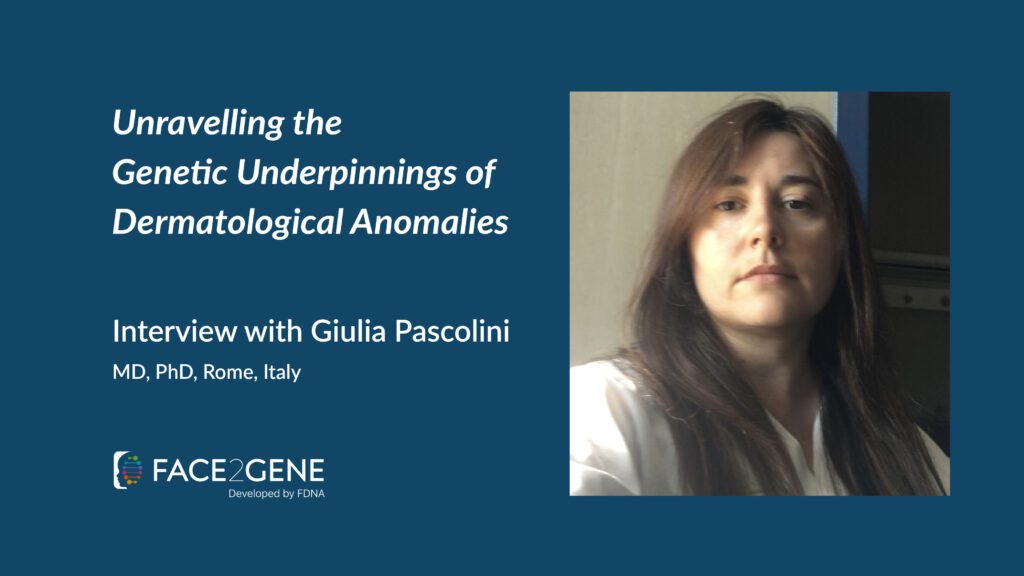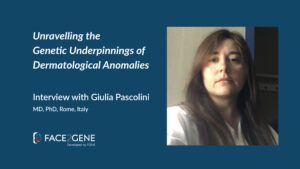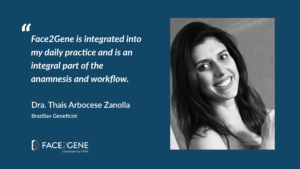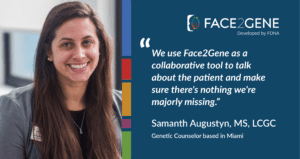Dr Giulia Pascolini, an esteemed Italian M.D. and Ph.D., is currently responsible for the Genetic Counselling Service of the Istituto Dermopatico dell’Immacolata (IDI-IRCCS) of Rome and is contributing her expertise to the Rare Skin Diseases Center of the same Institute. She is also a professor of Medical Genetics at the Medicine and Surgery Faculty of Tor Vergata University of Rome (nursing courses). Her research focuses on clinical dysmorphology, syndromology, and both syndromic and isolated intellectual disabilities. Additionally, Dr. Pascolini serves on the scientific advisory board of FDNA and is on the Editorial Board of the Pediatric Genetics Journal edited by Thieme. She is also in the Scientific Board of the ADNP syndrome Italian Association.
Dr. Giulia Pascolini’s work underscores the critical intersection of genetics and dermatology. By deepening our understanding of the genetic underpinnings of dermatological anomalies, she paves the way for more accurate diagnoses and targeted treatments. Her insights highlight the need for collaboration between dermatologists and geneticists, ensuring that patients with complex genetic conditions receive the comprehensive care they need. As research in this field continues to evolve, Dr. Pascolini’s contributions will undoubtedly play a pivotal role in advancing our knowledge and improving patient outcomes. Check out her insights below:
Genetics and Dermatology: An Intricate Relationship
Dr. Pascolini highlights the significance of understanding the genetic basis of dermatological conditions, particularly those arising from chromatin disturbances. “These genetic disruptions can manifest as cutaneous anomalies, and while some associations are well-known, others remain underexplored. Rubinstein-Taybi syndrome is a prime example of the association being well-documented,” she notes. Similarly, Koolen de-Vries syndrome often presents with pigment anomalies, such as spots and multiple nevi. Other conditions involve anomalies of hair and its appendages: “Hypertrichosis, seen in Coffin-Siris syndrome and more generically in BAF-opathies, is another well-known but underemphasized association,” Dr. Pascolini explains. Furthermore, ADNP syndrome has recently been linked to distinct cutaneous characteristics. In a study published in the American Journal of Medical Genetics Part A, Dr. Pascolini and her colleagues described these skin features, uncovering not only graphical thickening but also specific morphological anomalies.
The Role of Dermatologists in Genetic Pathologies
When asked if dermatologists know when to refer patients to geneticists, Dr. Pascolini asserts that while dermatologists are familiar with well-known genetic-based skin conditions, they might be less aware of those linked to chromatin disorders. “It’s understandable,” she says, “since dermatologists don’t encounter these cases as frequently as clinical geneticists do.”She emphasizes the importance of educating dermatologists to recognize when a genetic evaluation is warranted, particularly for chromatin-related anomalies and other rare syndromic presentations, which can manifest with not only skin features but also with appendages anomalies (hair, teeth, nails), mostly pediatric age.
Dr. Pascolini points out a specific sign that should raise suspicion among dermatologists: an accumulation around the elbow combined with facial dysmorphism, such as hypertelorism. “This characteristic should prompt further investigation into potential chromatin pathologies, including Wiedemann-Steiner syndrome” she advises.
Current Research and Future Directions
Dr. Pascolini’s current work at the Skin Rare Diseases Center of IDI-IRCCS, one of the most important Italian Clinical and Research Institutes for the skin diseases, investigating genetic aspects of skin pathologies and diseases with inherited oncological susceptibility, such as multiple and familial melanoma. Within these oncological susceptibility pathologies, syndromic forms, such as Rothmund-Thomson syndrome, also fall under her research scope. “These conditions are caused by genes that mediate DNA repair, making this an emerging and rapidly growing field,” she explains. In this group of genetic diseases are also encountered trichothiodystrophies, a very rare genodermatoses with peculiar hair pattern, which she is studying.
Her team is poised to join a national network for the Kleefstra syndrome, a project already underway in Lombardy. This initiative aims to establish a satellite Center across Italy for phenotypic characterization and material collection for in-depth genetic studies. Dr. Pascolini will play a crucial role in the clinical characterization of these patients in the regions of Central Italy, contributing her expertise to this collaborative effort.
Dr. Pascolini recounts a case where a child’s clinical presentation strongly resembled a published case, yet molecular analysis initially revealed no mutations. “Sometime later, the laboratory that conducted the analysis contacted me again, saying that the mutation was actually present in a different gene, but it resulted in a very similar phenotype”. Dr Giulia explains that for this particular case, Face2Gene was very useful because it confirmed the differential diagnosis and gave more basis to finding the mutation in a new gene, for a similar phenotype.



